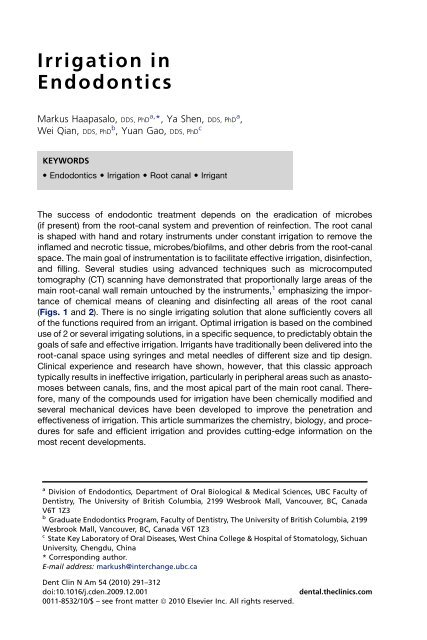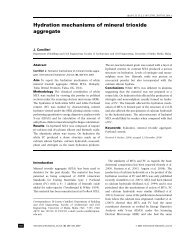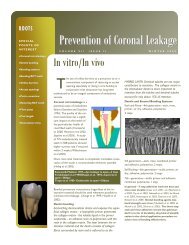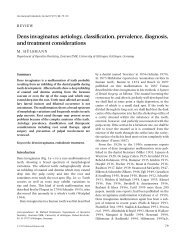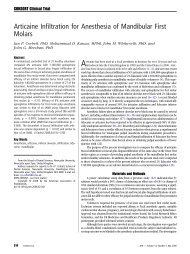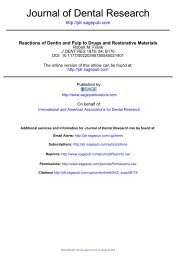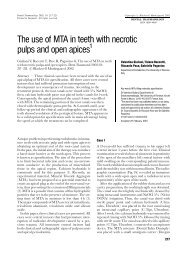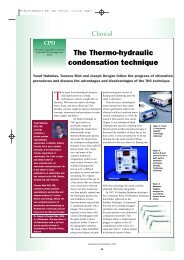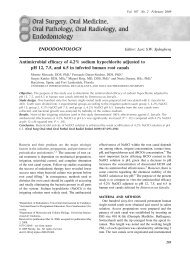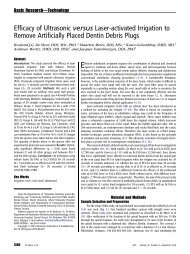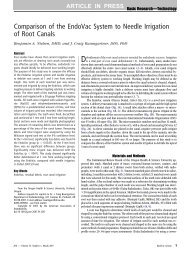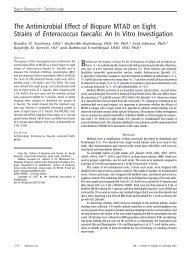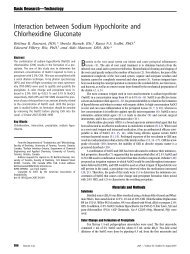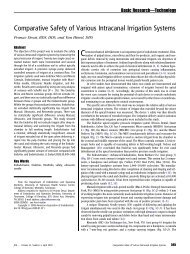Irrigation in Endodontics - The Endoexperience
Irrigation in Endodontics - The Endoexperience
Irrigation in Endodontics - The Endoexperience
You also want an ePaper? Increase the reach of your titles
YUMPU automatically turns print PDFs into web optimized ePapers that Google loves.
<strong>Irrigation</strong> <strong>in</strong><br />
<strong>Endodontics</strong><br />
Markus Haapasalo, DDS, PhD a, *, Ya Shen, DDS, PhD a ,<br />
Wei Qian, DDS, PhD b , Yuan Gao, DDS, PhD c<br />
KEYWORDS<br />
<strong>Endodontics</strong> <strong>Irrigation</strong> Root canal Irrigant<br />
<strong>The</strong> success of endodontic treatment depends on the eradication of microbes<br />
(if present) from the root-canal system and prevention of re<strong>in</strong>fection. <strong>The</strong> root canal<br />
is shaped with hand and rotary <strong>in</strong>struments under constant irrigation to remove the<br />
<strong>in</strong>flamed and necrotic tissue, microbes/biofilms, and other debris from the root-canal<br />
space. <strong>The</strong> ma<strong>in</strong> goal of <strong>in</strong>strumentation is to facilitate effective irrigation, dis<strong>in</strong>fection,<br />
and fill<strong>in</strong>g. Several studies us<strong>in</strong>g advanced techniques such as microcomputed<br />
tomography (CT) scann<strong>in</strong>g have demonstrated that proportionally large areas of the<br />
ma<strong>in</strong> root-canal wall rema<strong>in</strong> untouched by the <strong>in</strong>struments, 1 emphasiz<strong>in</strong>g the importance<br />
of chemical means of clean<strong>in</strong>g and dis<strong>in</strong>fect<strong>in</strong>g all areas of the root canal<br />
(Figs. 1 and 2). <strong>The</strong>re is no s<strong>in</strong>gle irrigat<strong>in</strong>g solution that alone sufficiently covers all<br />
of the functions required from an irrigant. Optimal irrigation is based on the comb<strong>in</strong>ed<br />
use of 2 or several irrigat<strong>in</strong>g solutions, <strong>in</strong> a specific sequence, to predictably obta<strong>in</strong> the<br />
goals of safe and effective irrigation. Irrigants have traditionally been delivered <strong>in</strong>to the<br />
root-canal space us<strong>in</strong>g syr<strong>in</strong>ges and metal needles of different size and tip design.<br />
Cl<strong>in</strong>ical experience and research have shown, however, that this classic approach<br />
typically results <strong>in</strong> <strong>in</strong>effective irrigation, particularly <strong>in</strong> peripheral areas such as anastomoses<br />
between canals, f<strong>in</strong>s, and the most apical part of the ma<strong>in</strong> root canal. <strong>The</strong>refore,<br />
many of the compounds used for irrigation have been chemically modified and<br />
several mechanical devices have been developed to improve the penetration and<br />
effectiveness of irrigation. This article summarizes the chemistry, biology, and procedures<br />
for safe and efficient irrigation and provides cutt<strong>in</strong>g-edge <strong>in</strong>formation on the<br />
most recent developments.<br />
a<br />
Division of <strong>Endodontics</strong>, Department of Oral Biological & Medical Sciences, UBC Faculty of<br />
Dentistry, <strong>The</strong> University of British Columbia, 2199 Wesbrook Mall, Vancouver, BC, Canada<br />
V6T 1Z3<br />
b<br />
Graduate <strong>Endodontics</strong> Program, Faculty of Dentistry, <strong>The</strong> University of British Columbia, 2199<br />
Wesbrook Mall, Vancouver, BC, Canada V6T 1Z3<br />
c<br />
State Key Laboratory of Oral Diseases, West Ch<strong>in</strong>a College & Hospital of Stomatology, Sichuan<br />
University, Chengdu, Ch<strong>in</strong>a<br />
* Correspond<strong>in</strong>g author.<br />
E-mail address: markush@<strong>in</strong>terchange.ubc.ca<br />
Dent Cl<strong>in</strong> N Am 54 (2010) 291–312<br />
doi:10.1016/j.cden.2009.12.001 dental.thecl<strong>in</strong>ics.com<br />
0011-8532/10/$ – see front matter ª 2010 Elsevier Inc. All rights reserved.
292<br />
Haapasalo et al<br />
Fig. 1. A scann<strong>in</strong>g electron microscopy image of dent<strong>in</strong> surface covered by predent<strong>in</strong> and<br />
other organic debris <strong>in</strong> an un<strong>in</strong>strumented canal area.<br />
GOALS OF IRRIGATION<br />
<strong>Irrigation</strong> has a central role <strong>in</strong> endodontic treatment. Dur<strong>in</strong>g and after <strong>in</strong>strumentation,<br />
the irrigants facilitate removal of microorganisms, tissue remnants, and dent<strong>in</strong> chips<br />
from the root canal through a flush<strong>in</strong>g mechanism (Box 1). Irrigants can also help<br />
prevent pack<strong>in</strong>g of the hard and soft tissue <strong>in</strong> the apical root canal and extrusion of <strong>in</strong>fected<br />
material <strong>in</strong>to the periapical area. Some irrigat<strong>in</strong>g solutions dissolve either organic<br />
or <strong>in</strong>organic tissue <strong>in</strong> the root canal. In addition, several irrigat<strong>in</strong>g solutions have antimicrobial<br />
activity and actively kill bacteria and yeasts when <strong>in</strong>troduced <strong>in</strong> direct contact<br />
with the microorganisms. However, several irrigat<strong>in</strong>g solutions also have cytotoxic<br />
potential, and they may cause severe pa<strong>in</strong> if they ga<strong>in</strong> access <strong>in</strong>to the periapical<br />
tissues. 2 An optimal irrigant should have all or most of the positive characteristics listed<br />
<strong>in</strong> Box 1, but none of the negative or harmful properties. None of the available irrigat<strong>in</strong>g<br />
solutions can be regarded as optimal. Us<strong>in</strong>g a comb<strong>in</strong>ation of products <strong>in</strong> the correct<br />
irrigation sequence contributes to a successful treatment outcome.<br />
IRRIGATING SOLUTIONS<br />
Sodium Hypochlorite<br />
Sodium hypochlorite (NaOCl) is the most popular irrigat<strong>in</strong>g solution. NaOCl ionizes <strong>in</strong><br />
water <strong>in</strong>to Na1 and the hypochlorite ion, OCl , establish<strong>in</strong>g an equilibrium with<br />
Fig. 2. Area of un<strong>in</strong>strumented root-canal wall.
Box 1<br />
Desired functions of irrigat<strong>in</strong>g solutions<br />
Wash<strong>in</strong>g action (helps remove debris)<br />
Reduce <strong>in</strong>strument friction dur<strong>in</strong>g preparation (lubricant)<br />
Facilitate dent<strong>in</strong> removal (lubricant)<br />
Dissolve <strong>in</strong>organic tissue (dent<strong>in</strong>)<br />
Penetrate to canal periphery<br />
Dissolve organic matter (dent<strong>in</strong> collagen, pulp tissue, biofilm)<br />
Kill bacteria and yeasts (also <strong>in</strong> biofilm)<br />
Do not irritate or damage vital periapical tissue, no caustic or cytotoxic effects<br />
Do not weaken tooth structure<br />
<strong>Irrigation</strong> <strong>in</strong> <strong>Endodontics</strong> 293<br />
hypochlorous acid (HOCl). At acidic and neutral pH, chlor<strong>in</strong>e exists predom<strong>in</strong>antly<br />
as HOCl, whereas at high pH of 9 and above, OCl predom<strong>in</strong>ates. 3 Hypochlorous<br />
acid is responsible for the antibacterial activity; the OCl ion is less effective<br />
than the undissolved HOCl. Hypochloric acid disrupts several vital functions of the<br />
microbial cell, result<strong>in</strong>g <strong>in</strong> cell death. 4,5<br />
NaOCl is commonly used <strong>in</strong> concentrations between 0.5% and 6%. It is a potent<br />
antimicrobial agent, kill<strong>in</strong>g most bacteria <strong>in</strong>stantly on direct contact. It also effectively<br />
dissolves pulpal remnants and collagen, the ma<strong>in</strong> organic components of dent<strong>in</strong>.<br />
Hypochlorite is the only root-canal irrigant of those <strong>in</strong> general use that dissolves<br />
necrotic and vital organic tissue. It is difficult to imag<strong>in</strong>e successful irrigation of the<br />
root canal without hypochlorite. Although hypochlorite alone does not remove the<br />
smear layer, it affects the organic part of the smear layer, mak<strong>in</strong>g its complete removal<br />
possible by subsequent irrigation with EDTA or citric acid (CA). It is used as an unbuffered<br />
solution at pH 11 <strong>in</strong> the various concentrations mentioned earlier, or buffered<br />
with bicarbonate buffer (pH 9.0), usually as a 0.5% (Dak<strong>in</strong> solution) or 1% solution. 3<br />
However, buffer<strong>in</strong>g does not seem to have any major effect on the properties of<br />
NaOCl, contrary to earlier belief. 6<br />
<strong>The</strong>re is considerable variation <strong>in</strong> the literature regard<strong>in</strong>g the antibacterial effect of<br />
NaOCl. In some articles hypochlorite is reported to kill the target microorganisms <strong>in</strong><br />
seconds, even at low concentrations, although other reports have published considerably<br />
longer times for the kill<strong>in</strong>g of the same species. 7–10 Such differences are a result<br />
of confound<strong>in</strong>g factors <strong>in</strong> some of the studies. <strong>The</strong> presence of organic matter dur<strong>in</strong>g<br />
the kill<strong>in</strong>g experiments has a great effect on the antibacterial activity of NaOCl.<br />
Haapasalo and colleagues 11 showed that the presence of dent<strong>in</strong> caused marked<br />
delays <strong>in</strong> the kill<strong>in</strong>g of Enterococcus faecalis by 1% NaOCl. Many of the earlier studies<br />
were performed <strong>in</strong> the presence of an unknown amount of organic matter (eg, nutrient<br />
broth) or without controll<strong>in</strong>g the pH of the culture, both of which affect the result. When<br />
the confound<strong>in</strong>g factors are elim<strong>in</strong>ated, it has been shown that NaOCl kills the target<br />
microorganisms rapidly even at low concentrations of less than 0.1%. 9,12 However, <strong>in</strong><br />
vivo the presence of organic matter (<strong>in</strong>flammatory exudate, tissue remnants, microbial<br />
biomass) consumes NaOCl and weakens its effect. <strong>The</strong>refore, cont<strong>in</strong>uous irrigation<br />
and time are important factors for the effectiveness of hypochlorite.<br />
Byström and Sundqvist 13,14 studied the irrigation of root canals that were necrotic<br />
and conta<strong>in</strong>ed a mixture of anaerobic bacteria. <strong>The</strong>se <strong>in</strong>vestigators showed that us<strong>in</strong>g
294<br />
Haapasalo et al<br />
0.5% or 5% NaOCl, with or without EDTA for irrigation, resulted <strong>in</strong> considerable reduction<br />
of bacterial counts <strong>in</strong> the canal when compared with irrigation with sal<strong>in</strong>e.<br />
However, it was difficult to render the canals completely free from bacteria, even after<br />
repeated sessions. Siqueira and colleagues 15 reported similar results us<strong>in</strong>g root<br />
canals <strong>in</strong>fected with E faecalis. Both studies failed to show a significant difference <strong>in</strong><br />
the antibacterial efficacy between the low and high concentrations of NaOCl. Contrary<br />
to these results, Clegg and colleagues, 16 <strong>in</strong> an ex vivo biofilm study, demonstrated<br />
a strong difference <strong>in</strong> the effectiveness aga<strong>in</strong>st biofilm bacteria by 6% and 3% NaOCl,<br />
the higher concentration be<strong>in</strong>g more effective.<br />
<strong>The</strong> weaknesses of NaOCl <strong>in</strong>clude the unpleasant taste, toxicity, and its <strong>in</strong>ability to<br />
remove the smear layer (Fig. 3) by itself, as it dissolves only organic material. 17<br />
<strong>The</strong> limited antimicrobial effectiveness of NaOCl <strong>in</strong> vivo is also disappo<strong>in</strong>t<strong>in</strong>g. <strong>The</strong><br />
poorer <strong>in</strong> vivo performance compared with <strong>in</strong> vitro is probably caused by problems<br />
<strong>in</strong> penetration to the most peripheral parts of the root-canal system such as f<strong>in</strong>s,<br />
anastomoses, apical canal, lateral canals, and dent<strong>in</strong> canals. Also, the presence of<br />
<strong>in</strong>activat<strong>in</strong>g substances such as exudate from the periapical area, pulp tissue, dent<strong>in</strong><br />
collagen, and microbial biomass counteract the effectiveness of NaOCl. 11 Recently, it<br />
has been shown by <strong>in</strong> vitro studies that long-term exposure of dent<strong>in</strong> to a high concentration<br />
sodium hypochlorite can have a detrimental effect on dent<strong>in</strong> elasticity and<br />
flexural strength. 18,19 Although there are no cl<strong>in</strong>ical data on this phenomenon, it raises<br />
the question of whether hypochlorite <strong>in</strong> some situations may <strong>in</strong>crease the risk of<br />
vertical root fracture.<br />
In summary, sodium hypochlorite is the most important irrigat<strong>in</strong>g solution and the<br />
only one capable of dissolv<strong>in</strong>g organic tissue, <strong>in</strong>clud<strong>in</strong>g biofilm and the organic part<br />
of the smear layer. It should be used throughout the <strong>in</strong>strumentation phase. However,<br />
use of hypochlorite as the f<strong>in</strong>al r<strong>in</strong>se follow<strong>in</strong>g EDTA or CA rapidly produces severe<br />
erosion of the canal-wall dent<strong>in</strong> and should probably be avoided. 20<br />
EDTA and CA<br />
Complete clean<strong>in</strong>g of the root-canal system requires the use of irrigants that dissolve<br />
organic and <strong>in</strong>organic material. As hypochlorite is active only aga<strong>in</strong>st the former, other<br />
substances must be used to complete the removal of the smear layer and dent<strong>in</strong><br />
debris. EDTA and CA effectively dissolve <strong>in</strong>organic material, <strong>in</strong>clud<strong>in</strong>g hydroxyapatite.<br />
21–24 <strong>The</strong>y have little or no effect on organic tissue and alone they do not have antibacterial<br />
activity, despite some conflict<strong>in</strong>g reports on EDTA. EDTA is most commonly<br />
Fig. 3. Cross section of root dent<strong>in</strong> covered by the smear layer created by <strong>in</strong>strumentation.<br />
Notice smear plugs <strong>in</strong> dent<strong>in</strong> canals.
<strong>Irrigation</strong> <strong>in</strong> <strong>Endodontics</strong> 295<br />
used as a 17% neutralized solution (disodium EDTA, pH 7), but a few reports have <strong>in</strong>dicated<br />
that solutions with lower concentrations (eg, 10%, 5%, and even 1%) remove<br />
the smear layer equally well after NaOCl irrigation. Consider<strong>in</strong>g the high cost of<br />
EDTA, it may be worthwhile to consider us<strong>in</strong>g diluted EDTA. CA is also marketed<br />
and used <strong>in</strong> various concentrations, rang<strong>in</strong>g from 1% to 50%, with a 10% solution<br />
be<strong>in</strong>g the most common. EDTA and CA are used for 2 to 3 m<strong>in</strong>utes at the end of <strong>in</strong>strumentation<br />
and after NaOCl irrigation. Removal of the smear layer by EDTA or CA<br />
improves the antibacterial effect of locally used dis<strong>in</strong>fect<strong>in</strong>g agents <strong>in</strong> deeper layers<br />
of dent<strong>in</strong>. 25,26 EDTA and CA are manufactured as liquids and gels. Although there<br />
are no comparative studies about the effectiveness of liquid and gel products to<br />
dem<strong>in</strong>eralize dent<strong>in</strong>, it is possible that the small volume of the root canal (only a few<br />
microliters) contributes to a rapid saturation of the chemical and thereby loss of effectiveness.<br />
In such situations, the use of liquid products and cont<strong>in</strong>uous irrigation should<br />
be recommended. 27,28<br />
Chlorhexid<strong>in</strong>e Digluconate<br />
Chlorhexid<strong>in</strong>e digluconate (CHX) is widely used <strong>in</strong> dis<strong>in</strong>fection <strong>in</strong> dentistry because of<br />
its good antimicrobial activity. 29–31 It has ga<strong>in</strong>ed considerable popularity <strong>in</strong> endodontics<br />
as an irrigat<strong>in</strong>g solution and as an <strong>in</strong>tracanal medicament. CHX does not possess<br />
some of the undesired characteristics of sodium hypochlorite (ie, bad smell and strong<br />
irritation to periapical tissues). However, CHX has no tissue-dissolv<strong>in</strong>g capability and<br />
therefore it cannot replace sodium hypochlorite.<br />
CHX permeates the microbial cell wall or outer membrane and attacks the bacterial<br />
cytoplasmic or <strong>in</strong>ner membrane or the yeast plasma membrane. In high concentrations,<br />
CHX causes coagulation of <strong>in</strong>tracellular components. 3 One of the reasons for<br />
the popularity of CHX is its substantivity (ie, cont<strong>in</strong>ued antimicrobial effect), because<br />
CHX b<strong>in</strong>ds to hard tissue and rema<strong>in</strong>s antimicrobial. However, similar to other<br />
endodontic dis<strong>in</strong>fect<strong>in</strong>g agents, the activity of CHX depends on the pH and is also<br />
greatly reduced <strong>in</strong> the presence of organic matter. 31<br />
Several studies have compared the antibacterial effect of NaOCl and 2% CHX<br />
aga<strong>in</strong>st <strong>in</strong>tracanal <strong>in</strong>fection and have shown little or no difference between<br />
their antimicrobial effectiveness. 32–35 Although bacteria may be killed by CHX, the biofilm<br />
and other organic debris are not removed by it. Residual organic tissue may have<br />
a negative effect on the quality of the seal by the permanent root fill<strong>in</strong>g, necessitat<strong>in</strong>g<br />
the use of NaOCl dur<strong>in</strong>g <strong>in</strong>strumentation. However, CHX does not cause erosion of<br />
dent<strong>in</strong> like NaOCl does as the f<strong>in</strong>al r<strong>in</strong>se after EDTA, and therefore 2% CHX may be<br />
a good choice for maximized antibacterial effect at the end of the chemomechanical<br />
preparation. 36<br />
Most of the research on the use of CHX <strong>in</strong> endodontics is carried out us<strong>in</strong>g <strong>in</strong> vitro<br />
and ex vivo models and gram-positive test organisms, mostly E faecalis. It is therefore<br />
possible that the studies have given an overpositive picture of the usefulness of CHX<br />
as an antimicrobial agent <strong>in</strong> endodontics. More research is needed to identify the<br />
optimal irrigation regimen for various types of endodontic treatments. CHX is<br />
marketed as a water-based solution and as a gel (with Natrosol). Some studies<br />
have <strong>in</strong>dicated that the CHX gel has a slightly better performance than the CHX liquid<br />
but the reasons for possible differences are not known. 37<br />
Other Irrigat<strong>in</strong>g Solutions<br />
Other irrigat<strong>in</strong>g solutions used <strong>in</strong> endodontics have <strong>in</strong>cluded sterile water, physiologic<br />
sal<strong>in</strong>e, hydrogen peroxide, urea peroxide, and iod<strong>in</strong>e compounds. All of these except<br />
iod<strong>in</strong>e compounds lack antibacterial activity when used alone, and they do not
296<br />
Haapasalo et al<br />
dissolve tissue either. <strong>The</strong>refore there is no good reason for their use <strong>in</strong> canal irrigation<br />
<strong>in</strong> rout<strong>in</strong>e cases. In addition, water and sal<strong>in</strong>e solutions bear the risk of contam<strong>in</strong>ation if<br />
used from conta<strong>in</strong>ers that have been opened more than once. Iod<strong>in</strong>e potassium iodide<br />
(eg, 2% and 4%, respectively) has considerable antimicrobial activity but no tissuedissolv<strong>in</strong>g<br />
capability 38,39 and it could be used at the end of the chemomechanical<br />
preparation like CHX. However, some patients are allergic to iod<strong>in</strong>e, which must be<br />
taken <strong>in</strong>to consideration.<br />
Interactions Between Irrigat<strong>in</strong>g Solutions<br />
Hypochlorite and EDTA are the 2 most commonly used irrigat<strong>in</strong>g solutions. As they<br />
have different characteristics and tasks, it has been tempt<strong>in</strong>g to use them as a mixture.<br />
However, EDTA (and CA) <strong>in</strong>stantaneously reduces the amount of chlor<strong>in</strong>e when mixed<br />
with sodium hypochlorite, result<strong>in</strong>g <strong>in</strong> the loss of NaOCl activity. Thus, these solutions<br />
should not be mixed. 40<br />
CHX has no tissue-dissolv<strong>in</strong>g activity and there have been efforts to comb<strong>in</strong>e CHX<br />
with hypochlorite for added benefits from the 2 solutions. However, CHX and NaOCl<br />
are not soluble <strong>in</strong> each other; a brownish-orange precipitate is formed when they are<br />
mixed (Fig. 4). <strong>The</strong> characteristics of the precipitate and the liquid phase have not<br />
been thoroughly exam<strong>in</strong>ed, but the precipitate prevents the cl<strong>in</strong>ical use of the mixture.<br />
Atomic absorption spectrophotometry has <strong>in</strong>dicated that the precipitate conta<strong>in</strong>s iron,<br />
which may be the reason for the orange development. 41 Presence of parachloroanil<strong>in</strong>e,<br />
which may have mutagenic potential, has also been demonstrated <strong>in</strong> the<br />
precipitate. 42,43<br />
Mix<strong>in</strong>g CHX and EDTA immediately produces a white precipitate (Fig. 5). Although<br />
the properties of the mixture and the cleared supernatant have not been thoroughly<br />
studied, it seems that the ability of EDTA to remove the smear layer is reduced.<br />
Many cl<strong>in</strong>icians mix NaOCl with hydrogen peroxide for root-canal irrigation. Despite<br />
more vigorous bubbl<strong>in</strong>g, the effectiveness of the mixture has not been shown to be<br />
Fig. 4. Orange precipitate formed by mix<strong>in</strong>g chlorhexid<strong>in</strong>e with sodium hypochlorite.
<strong>Irrigation</strong> <strong>in</strong> <strong>Endodontics</strong> 297<br />
Fig. 5. Mix<strong>in</strong>g sodium chlorhexid<strong>in</strong>e with EDTA produces a white cloud and some<br />
precipitation.<br />
better than that of NaOCl alone. 32 However, comb<strong>in</strong><strong>in</strong>g hydrogen peroxide with CHX<br />
<strong>in</strong> an ex vivo model 32,44 resulted <strong>in</strong> a considerable <strong>in</strong>crease <strong>in</strong> the antibacterial activity<br />
of the mixture compared with the components alone <strong>in</strong> an <strong>in</strong>fected dent<strong>in</strong> block.<br />
However, there are no data concern<strong>in</strong>g the use or effectiveness of the mixture <strong>in</strong><br />
cl<strong>in</strong>ical use.<br />
Comb<strong>in</strong>ation Products<br />
Although some of the ma<strong>in</strong> irrigat<strong>in</strong>g solutions cannot be mixed without loss of activity<br />
or development of potentially toxic by-products, several comb<strong>in</strong>ation products are on<br />
the market, many with some evidence of improved activity and function. Surfaceactive<br />
agents have been added to several different types of irrigants to lower their<br />
surface tension and to improve their penetration <strong>in</strong> the root canal. In the hope of better<br />
smear-layer removal, detergents have been added to some EDTA preparations<br />
(eg, SmearClear (Fig. 6)) 45 and hypoclorite (eg, Chlor-XTRA (Fig. 7) and White K<strong>in</strong>g).<br />
Detergent addition has been shown to <strong>in</strong>crease the speed of tissue dissolution by<br />
hypochlorite. 46 No data are available on whether dent<strong>in</strong> penetration is also improved.<br />
Recently, a few studies have been published <strong>in</strong> which the antibacterial activity of<br />
a chlorhexid<strong>in</strong>e product with surface-active agents (CHX-Plus; see Fig. 7) has been<br />
compared with regular CHX, both with 2% chlorhexid<strong>in</strong>e concentrations. <strong>The</strong><br />
studies47,48 have shown superior kill<strong>in</strong>g of planktonic and biofilm bacteria by the<br />
comb<strong>in</strong>ation product. <strong>The</strong>re are no studies about whether add<strong>in</strong>g surface-active<br />
agents <strong>in</strong>creases the risk of the irrigants escap<strong>in</strong>g to the periapical area <strong>in</strong> cl<strong>in</strong>ical use.<br />
MTAD (a mixture of tetracycl<strong>in</strong>e isomer, acid, and detergent, Biopure, Tulsa Dentsply,<br />
Tulsa, OK, USA) and Tetraclean are new comb<strong>in</strong>ation products for root-canal<br />
irrigation that conta<strong>in</strong> an antibiotic, doxycycl<strong>in</strong>e. 49–51 MTAD and Tetraclean are
298<br />
Haapasalo et al<br />
Fig. 6. SmearClear is a comb<strong>in</strong>ation product conta<strong>in</strong><strong>in</strong>g EDTA and a detergent.<br />
designed primarily for smear-layer removal with added antimicrobial activity. Both<br />
conta<strong>in</strong> CA, doxycycl<strong>in</strong>e, and a detergent. <strong>The</strong>y differ from each other <strong>in</strong> CA concentration<br />
and type of detergent <strong>in</strong>cluded. <strong>The</strong>y do not dissolve organic tissue and are <strong>in</strong>tended<br />
for use at the end of chemomechanical preparation after sodium hypochlorite.<br />
Although earlier studies showed promis<strong>in</strong>g antibacterial effects by MTAD, 52,53 recent<br />
studies have <strong>in</strong>dicated that an NaOCl/EDTA comb<strong>in</strong>ation is equally or more effective<br />
Fig. 7. Chlor-XTRA and CHX-Plus are comb<strong>in</strong>ation products whose tissue dissolution or<br />
antibacterial properties have been improved by specific surface-active agents.
<strong>Irrigation</strong> <strong>in</strong> <strong>Endodontics</strong> 299<br />
than NaOCl/MTAD. 54,55 Comparative studies on MATD and Tetraclean have <strong>in</strong>dicated<br />
better antibacterial effects by the latter. 56 Although a mixture conta<strong>in</strong><strong>in</strong>g an antibiotic<br />
may have good short-term and long-term effects, concerns have been expressed<br />
regard<strong>in</strong>g the use of tetracycl<strong>in</strong>e (doxycycl<strong>in</strong>e) because of possible resistance to the<br />
antibiotic and sta<strong>in</strong><strong>in</strong>g of the tooth hard tissue, which has been demonstrated by exposure<br />
to light <strong>in</strong> an <strong>in</strong> vitro expreriment. 57 However, no report of <strong>in</strong> vivo sta<strong>in</strong><strong>in</strong>g has been<br />
published.<br />
CHALLENGES OF IRRIGATION<br />
Smear Layer<br />
Removal of the smear layer is straightforward and predictable when the correct<br />
irrigants are used. Rely<strong>in</strong>g on EDTA alone or other irrigants with activity aga<strong>in</strong>st the<br />
<strong>in</strong>organic matter only, however, results <strong>in</strong> <strong>in</strong>complete removal of the layer. <strong>The</strong>refore,<br />
use of hypochlorite dur<strong>in</strong>g <strong>in</strong>strumentation cannot be omitted (Fig. 8). <strong>The</strong> smear layer<br />
is created only on areas touched by the <strong>in</strong>struments. Delivery of irrigants to these<br />
areas is usually unproblematic, with the possible exception of the most apical canal,<br />
depend<strong>in</strong>g on canal morphology and the techniques/equipment used for irrigation.<br />
However, careless irrigation, with needles <strong>in</strong>troduced only to the coronal and middle<br />
parts of the root canal, is likely to result <strong>in</strong> <strong>in</strong>complete removal of the smear layer <strong>in</strong><br />
the apical root canal.<br />
Dent<strong>in</strong> Erosion<br />
One of the goals of endodontic treatment is to protect the tooth structure so that the<br />
physical procedures and chemical treatments do not cause weaken<strong>in</strong>g of the dent<strong>in</strong>/<br />
root. Erosion of dent<strong>in</strong> has not been studied much; however, there is a general<br />
consensus that dent<strong>in</strong> erosion may be harmful and should be avoided. A few studies<br />
have shown that long-term exposure to high concentrations of hypochlorite can lead<br />
to considerable reduction <strong>in</strong> the flexural strength and elastic modus of dent<strong>in</strong>. 19 <strong>The</strong>se<br />
studies have been performed <strong>in</strong> vitro us<strong>in</strong>g dent<strong>in</strong> blocks, which may allow artificially<br />
deep penetration of hypoclorite <strong>in</strong>to dent<strong>in</strong>. However, even short-term irrigation with<br />
hypochlorite after EDTA or CA at the end of chemomechanical preparation causes<br />
strong erosion of the canal-wall surface dent<strong>in</strong> (Fig. 9). 20 Although it is not known<br />
for sure whether surface erosion is a negative issue or if, for example, it could improve<br />
dent<strong>in</strong> bond<strong>in</strong>g for posts, it is the authors’ op<strong>in</strong>ion that hypochlorite irrigation after<br />
Fig. 8. Instrumented canal wall after removal of the smear layer by NaOCl and EDTA.
300<br />
Haapasalo et al<br />
Fig. 9. Considerable erosion of canal-wall dent<strong>in</strong> occurs when hypochlorite is used after<br />
EDTA or CA.<br />
dem<strong>in</strong>eralization agents should be avoided. Instead, chlorhexid<strong>in</strong>e irrigation could be<br />
used for additional dis<strong>in</strong>fection at the end of the treatment.<br />
Clean<strong>in</strong>g of Un<strong>in</strong>strumented Parts of the Root-canal System<br />
<strong>Irrigation</strong> is most feasible <strong>in</strong> the <strong>in</strong>strumented areas because the irrigation needle can<br />
follow the smooth path created by the <strong>in</strong>struments. Clean<strong>in</strong>g and remov<strong>in</strong>g of necrotic<br />
tissue, debris, and biofilms from untouched areas rely completely on chemical means,<br />
and sufficient use of sodium hypochlorite is the key factor <strong>in</strong> obta<strong>in</strong><strong>in</strong>g the desired<br />
results <strong>in</strong> these areas (Fig. 10). A recent study showed that untouched areas, <strong>in</strong><br />
particular anastomoses between canals, are frequently packed with debris dur<strong>in</strong>g<br />
<strong>in</strong>strumentation. 58 Visibility <strong>in</strong> micro-CT scans <strong>in</strong>dicates that the debris also conta<strong>in</strong><br />
a considerable proportion of <strong>in</strong>organic material (Fig. 11). Although at present it is<br />
not known how these debris can best be removed (if at all), it is likely that physical<br />
agitation (eg, ultrasound) and the use of dem<strong>in</strong>eraliz<strong>in</strong>g agents are needed <strong>in</strong> addition<br />
to hypochlorite.<br />
Biofilm<br />
Biofilm (Fig. 12) can be removed or elim<strong>in</strong>ated through the follow<strong>in</strong>g methods:<br />
mechanical removal by <strong>in</strong>struments (effective only <strong>in</strong> some areas of the root canal);<br />
Fig. 10. Canal-wall dent<strong>in</strong> <strong>in</strong> an un<strong>in</strong>strumented area after hypochlorite irrigation has<br />
removed (dissolved) tissue remnants and predent<strong>in</strong>, reveal<strong>in</strong>g the large calcospherites<br />
that have already jo<strong>in</strong>ed m<strong>in</strong>eralized dent<strong>in</strong>.
Fig. 11. An anastomosis between 2 jo<strong>in</strong><strong>in</strong>g canals has been packed with debris dur<strong>in</strong>g rotary<br />
<strong>in</strong>strumentation.<br />
dissolution by hypochlorite; and detachment by ultrasonic energy. Other chemical<br />
means, such as chlorhexid<strong>in</strong>e, can kill biofilm bacteria if allowed a long enough<br />
contact time. However, as they lack tissue-dissolv<strong>in</strong>g ability, the dead microbial<br />
biomass stays <strong>in</strong> the canal if not removed mechanically or dissolved by hypochlorite.<br />
Any rema<strong>in</strong><strong>in</strong>g organic matter, microbes, or vital or necrotic tissue jeopardizes the<br />
<strong>in</strong>tegrity of the seal of the root fill<strong>in</strong>g. <strong>The</strong>refore the goal of the treatment is not only<br />
to kill the microbes <strong>in</strong> the root canal but also to remove them as completely as<br />
possible.<br />
Safety versus Effectiveness <strong>in</strong> the Apical Root Canal<br />
<strong>Irrigation</strong> must ma<strong>in</strong>ta<strong>in</strong> a balance between 2 important goals: safety and effectiveness.<br />
This po<strong>in</strong>t is particularly true with the most important irrigant, sodium hypochlorite,<br />
but other irrigants can also cause pa<strong>in</strong> and other problems if they ga<strong>in</strong> access to<br />
the periapical tissues. Effectiveness is often jeopardized <strong>in</strong> the apical root canal by<br />
restrict<strong>in</strong>g anatomy and valid safety concerns. However, the eradication of the<br />
microbes <strong>in</strong> the apical canal should be of key importance to the success of endodontic<br />
Fig. 12. Bacteria grow<strong>in</strong>g on dent<strong>in</strong> surface; early stages of biofilm formation.<br />
<strong>Irrigation</strong> <strong>in</strong> <strong>Endodontics</strong> 301
302<br />
Haapasalo et al<br />
treatment. Sufficient exchange of hypochlorite and other irrigants <strong>in</strong> this area while<br />
keep<strong>in</strong>g the apical pressure of the solutions m<strong>in</strong>imal is the obvious goal of irrigation<br />
of the apical root canal. A better understand<strong>in</strong>g of fluid dynamics and the development<br />
of new needle designs and equipment for irrigant delivery are the 2 important areas to<br />
deal with <strong>in</strong> the challenges of irrigat<strong>in</strong>g the most apical part of the canal. <strong>The</strong>se areas<br />
are discussed <strong>in</strong> the follow<strong>in</strong>g sections.<br />
COMPUTATIONAL FLUID DYNAMICS IN THE ROOT-CANAL SPACE<br />
Computational fluid dynamics (CFD) is a new approach <strong>in</strong> endodontic research to<br />
improve our understand<strong>in</strong>g of fluid dynamics <strong>in</strong> the special anatomic environment of<br />
the root canal. Fluid flow is commonly studied <strong>in</strong> 1 of 3 ways: experimental fluid<br />
dynamics; theoretic fluid dynamics; and computational fluid dynamics (Fig. 13).<br />
CFD is the science that focuses on predict<strong>in</strong>g fluid flow and related phenomena by<br />
solv<strong>in</strong>g the mathematical equations that govern these processes. Numerical and<br />
experimental approaches play complementary roles <strong>in</strong> the <strong>in</strong>vestigation of fluid flow.<br />
Experimental studies have the advantage of physical realism; once the numerical<br />
model is experimentally validated, it can be used to theoretically simulate various<br />
conditions and perform parametric <strong>in</strong>vestigations. CFD can be used to evaluate and<br />
predict specific parameters, such as the streaml<strong>in</strong>e (Fig. 14), velocity distribution of<br />
irrigant flow <strong>in</strong> the root canal (Fig. 15), wall flow pressure, and wall shear stress on<br />
the root-canal wall, which are difficult to measure <strong>in</strong> vivo because of the microscopic<br />
size of the root canals.<br />
In CFD studies, no s<strong>in</strong>gle turbulence model is universally accepted for different<br />
types of flow environments. <strong>The</strong> use of an unsuitable turbulence model may lead to<br />
potential numerical errors and affect CFD results. 59 Gao and colleagues 60 found<br />
that CFD analysis based on a shear stress transport (SST) k-u turbulence model<br />
Fig. 13. Particle track<strong>in</strong>g dur<strong>in</strong>g irrigation simulated by a CFD model.
Fig. 14. Streaml<strong>in</strong>e provides visualization of the irrigant flow <strong>in</strong> the canal.<br />
<strong>Irrigation</strong> <strong>in</strong> <strong>Endodontics</strong> 303<br />
was <strong>in</strong> close agreement with the <strong>in</strong> vitro irrigation model. CFD based on an SST k-u<br />
turbulence model has the potential to serve as a platform for the study of root-canal<br />
irrigation.<br />
<strong>The</strong> irrigant velocity on the canal wall is considered a highly significant factor <strong>in</strong><br />
determ<strong>in</strong><strong>in</strong>g the replacement of the irrigant <strong>in</strong> certa<strong>in</strong> parts of the root canal and<br />
Fig. 15. Velocity contour and vectors colored by velocity magnitude <strong>in</strong> an SST k-u turbulence<br />
model. High-velocity flow seen <strong>in</strong> the needle lumen and <strong>in</strong> the area of the side vent.
304<br />
Haapasalo et al<br />
<strong>in</strong> the flush effect, therefore directly <strong>in</strong>fluenc<strong>in</strong>g the effectiveness of irrigation. 61 In<br />
a turbulent flow, there is a viscous sublayer that is a th<strong>in</strong> region next to a wall, typically<br />
only 1% of the boundary-layer thickness, <strong>in</strong> which turbulent mix<strong>in</strong>g is impeded and<br />
transport occurs partly or, as the limit of the wall is approached, entirely by viscous<br />
diffusion. 62 From turbulent structure measurements of pipe flow, the regions of<br />
maximum production and maximum dissipation are just outside the viscous sublayer.<br />
63 Hence, the fastest flow is found <strong>in</strong> the turbulent boundary, whereas the<br />
m<strong>in</strong>imum velocity is observed on the wall of all root-canal irrigations. Some of the<br />
goals of CFD studies <strong>in</strong> endodontics are to improve needle-tip design for effective<br />
and safe delivery of the irrigant and to optimize the exchange of irrigat<strong>in</strong>g solutions<br />
<strong>in</strong> the peripheral parts of the canal system.<br />
IRRIGATION DEVICES AND TECHNIQUES<br />
<strong>The</strong> effectiveness and safety of irrigation depends on the means of delivery. Traditionally,<br />
irrigation has been performed with a plastic syr<strong>in</strong>ge and an open-ended needle<br />
<strong>in</strong>to the canal space. An <strong>in</strong>creas<strong>in</strong>g number of novel needle-tip designs and equipment<br />
are emerg<strong>in</strong>g <strong>in</strong> an effort to better address the challenges of irrigation.<br />
Syr<strong>in</strong>ges<br />
Plastic syr<strong>in</strong>ges of different sizes (1–20 mL) are most commonly used for irrigation<br />
(Fig. 16). Although large-volume syr<strong>in</strong>ges potentially allow some time-sav<strong>in</strong>gs, they<br />
are more difficult to control for pressure and accidents may happen. <strong>The</strong>refore, to<br />
maximize safety and control, use of 1- to 5-mL syr<strong>in</strong>ges is recommended <strong>in</strong>stead of<br />
the larger ones. All syr<strong>in</strong>ges for endodontic irrigation must have a Luer-Lok design.<br />
Because of the chemical reactions between many irrigants, separate syr<strong>in</strong>ges should<br />
be used for each solution.<br />
Needles<br />
Although 25-gauge needles were commonplace for endodontic irrigation a few years<br />
ago, they were first replaced by 27-G needles, now 30-G and even 31-G needles are<br />
tak<strong>in</strong>g over for rout<strong>in</strong>e use <strong>in</strong> irrigation. As 27 G corresponds to International Standards<br />
Fig. 16. Plastic syr<strong>in</strong>ges for irrigation.
<strong>Irrigation</strong> <strong>in</strong> <strong>Endodontics</strong> 305<br />
Organization size 0.42 and 30 G to size 0.31, smaller needle sizes are preferred.<br />
Several studies have shown that the irrigant has only a limited effect beyond the tip<br />
of the needle because of the dead-water zone or sometimes air bubbles <strong>in</strong> the apical<br />
root canal, which prevent apical penetration of the solution. However, although the<br />
smaller needles allow delivery of the irrigant close to the apex, this is not without safety<br />
concerns. Several modifications of the needle-tip design have been <strong>in</strong>troduced <strong>in</strong><br />
recent years to facilitate effectiveness and m<strong>in</strong>imize safety risks (Figs. 17 and 18).<br />
<strong>The</strong>re are few comparative data about the effect of needle design on irrigation effectiveness;<br />
it is hoped that ongo<strong>in</strong>g CFD and cl<strong>in</strong>ical studies will change this situation.<br />
Gutta-percha Po<strong>in</strong>ts<br />
<strong>The</strong> recognition of the difficulty of apical canal irrigation has led to various <strong>in</strong>novative<br />
techniques to facilitate the penetration of solutions <strong>in</strong> the canal. One of these <strong>in</strong>cludes<br />
the use of apically fitt<strong>in</strong>g gutta-percha cones <strong>in</strong> an up-and-down motion at the work<strong>in</strong>g<br />
length. Although this facilitates the exchange of the apical solution, the overall volume<br />
of fresh solution <strong>in</strong> the apical canal is likely to rema<strong>in</strong> small. However, the benefits of<br />
gutta-percha po<strong>in</strong>t assisted irrigation have been shown <strong>in</strong> 2 recent studies. 64,65<br />
EndoActivator<br />
EndoActivator (Advanced <strong>Endodontics</strong>, Santa Barbara, CA, USA) is a new type of<br />
irrigation facilitator. It is based on sonic vibration (up to 10,000 cpm) of a plastic tip<br />
<strong>in</strong> the root canal. <strong>The</strong> system has 3 different sizes of tips that are easily attached<br />
(snap-on) to the handpiece that creates the sonic vibrations (Fig. 19). EndoActivator<br />
does not deliver new irrigant to the canal but it facilitates the penetration and renewal<br />
of the irrigant <strong>in</strong> the canal. Two recent studies have <strong>in</strong>dicated that the use of EndoActivator<br />
facilitates irrigant penetration and mechanical cleans<strong>in</strong>g compared with needle<br />
irrigation, with no <strong>in</strong>crease <strong>in</strong> the risk of irrigant extrusion through the apex. 66,67<br />
Fig. 17. Four different needle designs, produced by computerized mesh models based on<br />
true and virtual needles.
306<br />
Haapasalo et al<br />
Fig. 18. Flexiglide needle for irrigation also easily follows curved canals.<br />
Vibr<strong>in</strong>ge<br />
Vibr<strong>in</strong>ge (Vibr<strong>in</strong>ge BV, Amsterdam, <strong>The</strong> Netherlands) is a new sonic irrigation system<br />
that comb<strong>in</strong>es battery-driven vibrations (9000 cpm) with manually operated irrigation<br />
of the root canal (Fig. 20). Vibr<strong>in</strong>ge uses the traditional type of syr<strong>in</strong>ge/needle delivery<br />
but adds sonic vibration. No studies can be found on Medl<strong>in</strong>e.<br />
R<strong>in</strong>sEndo<br />
<strong>The</strong> R<strong>in</strong>sEndo system (Durr Dental Co) is based on a pressure-suction mechanism<br />
with approximately 100 cycles per m<strong>in</strong>ute. 68 A study of the safety of several irrigation<br />
systems reported that the risk of overirrigation was comparable with manual and<br />
R<strong>in</strong>sEndo irrigation, but higher than with EndoActivator or the EndoVac system. 67<br />
Not enough data are available to draw conclusions about the benefits and possible<br />
risks of the R<strong>in</strong>sEndo system.<br />
EndoVac<br />
EndoVac (Discus Dental, Culver City, CA, USA) represents a novel approach to irrigation<br />
as, <strong>in</strong>stead of deliver<strong>in</strong>g the irrigant through the needle, the EndoVac system is<br />
based on a negative-pressure approach whereby the irrigant placed <strong>in</strong> the pulp<br />
chamber is sucked down the root canal and back up aga<strong>in</strong> through a th<strong>in</strong> needle with<br />
a special design (Fig. 21). <strong>The</strong>re is evidence that, compared with traditional needle<br />
irrigation and some other systems, the EndoVac system lowers the risks associated<br />
with irrigation close to the apical foramen considerably. 67 Another advantage of the<br />
reversed flow of irrigants may be good apical clean<strong>in</strong>g at the 1-mm level and a strong<br />
antibacterial effect when hypochlorite is used, as shown by recent studies. 69,70<br />
Fig. 19. (A) EndoActivator with the large (blue) plastic tip. (B) Same tip <strong>in</strong> sonic motion.
Fig. 20. Vibr<strong>in</strong>ge irrigator creates sonic vibrations <strong>in</strong> the syr<strong>in</strong>ge and needle.<br />
Ultrasound<br />
<strong>Irrigation</strong> <strong>in</strong> <strong>Endodontics</strong> 307<br />
<strong>The</strong> use of ultrasonic energy for clean<strong>in</strong>g of the root canal and to facilitate dis<strong>in</strong>fection<br />
has a long history <strong>in</strong> endodontics. <strong>The</strong> comparative effectiveness of ultrasonics and<br />
hand-<strong>in</strong>strumentation techniques has been evaluated <strong>in</strong> several earlier studies. 71–74<br />
Most of these studies concluded that ultrasonics, together with an irrigant, contributed<br />
to a better clean<strong>in</strong>g of the root-canal system than irrigation and hand-<strong>in</strong>strumentation<br />
alone. Cavitation and acoustic stream<strong>in</strong>g of the irrigant contribute to the biologicchemical<br />
activity for maximum effectiveness. 75 Analysis of the physical mechanisms<br />
of the hydrodynamic response of an oscillat<strong>in</strong>g ultrasonic file suggested that stable<br />
and transient cavitation of a file, steady stream<strong>in</strong>g, and cavitation microstream<strong>in</strong>g all<br />
contribute to the clean<strong>in</strong>g of the root canal. 76 Ultrasonic files must have free movement<br />
<strong>in</strong> the canal without mak<strong>in</strong>g contact with the canal wall to work effectively. 77<br />
Several studies have <strong>in</strong>dicated the importance of ultrasonic preparation for optimal<br />
Fig. 21. EndoVac system uses negative pressure to make safe and effective irrigation of the<br />
most apical canal possible. <strong>The</strong> irrigant <strong>in</strong> the pulp chamber is sucked down the root canal<br />
and back up aga<strong>in</strong> via the needle, opposite to the classic method of irrigation.
308<br />
Haapasalo et al<br />
debridement of anastomoses between double canals, isthmuses, and f<strong>in</strong>s. 78–80 <strong>The</strong><br />
effectiveness of ultrasonics <strong>in</strong> the elim<strong>in</strong>ation of bacteria and dent<strong>in</strong> debris from<br />
the canals has been shown by several studies. 81–85 However, not all studies have<br />
supported these f<strong>in</strong>d<strong>in</strong>gs. 80<br />
Van der Sluis and colleagues 84 suggested that a smooth wire dur<strong>in</strong>g ultrasonic<br />
irrigation is as effective as a size 15 K-file <strong>in</strong> the removal of artificially placed dent<strong>in</strong><br />
debris <strong>in</strong> grooves <strong>in</strong> simulated root canals <strong>in</strong> res<strong>in</strong> blocks. It is possible that preparation<br />
complications are less likely to occur with an ultrasonic tip with a smooth, <strong>in</strong>active<br />
surface.<br />
SUMMARY<br />
<strong>Irrigation</strong> has a key role <strong>in</strong> successful endodontic treatment. Although hypochlorite is<br />
the most important irrigat<strong>in</strong>g solution, no s<strong>in</strong>gle irrigant can accomplish all the tasks<br />
required by irrigation. Detailed understand<strong>in</strong>g of the mode of action of various<br />
solutions is important for optimal irrigation. New developments such as CFD and<br />
mechanical devices will help to advance safe and effective irrigation.<br />
ACKNOWLEDGMENTS<br />
<strong>The</strong> authors would like to thank Ingrid Ellis for her editorial assistance <strong>in</strong> the f<strong>in</strong>al<br />
preparation of this manuscript.<br />
REFERENCES<br />
1. Peters OA, Schönenberger K, Laib A. Effects of four Ni-Ti preparation techniques<br />
on root canal geometry assessed by micro computed tomography. Int Endod J<br />
2001;34:221–30.<br />
2. Hülsmann M, Hahn W. Complications dur<strong>in</strong>g root canal irrigation: literature review<br />
and case reports [review]. Int Endod J 2000;33:186–93.<br />
3. Mcdonnell G, Russell D. Antiseptics and dis<strong>in</strong>fectants: activity, action, and resistance.<br />
Cl<strong>in</strong> Microbiol Rev 1999;12:147–79.<br />
4. Barrette WC Jr, Hannum DM, Wheeler WD, et al. General mechanism for the<br />
bacterial toxicity of hypochlorous acid: abolition of ATP production. Biochemistry<br />
1989;28:9172–8.<br />
5. McKenna SM, Davies KJA. <strong>The</strong> <strong>in</strong>hibition of bacterial growth by hypochlorous<br />
acid. Biochem J 1988;254:685–92.<br />
6. Zehnder M, Kosicki D, Luder H, et al. Tissue-dissolv<strong>in</strong>g capacity and antibacterial<br />
effect of buffered and unbuffered hypochlorite solutions. Oral Surg Oral Med Oral<br />
Pathol Oral Radiol Endod 2002;94:756–62.<br />
7. Gomes BP, Ferraz CC, Vianna ME, et al. In vitro antimicrobial activity of several<br />
concentrations of sodium hypochlorite and chlorhexid<strong>in</strong>e gluconate <strong>in</strong> the elim<strong>in</strong>ation<br />
of Enterococcus faecalis. Int Endod J 2001;34:424–8.<br />
8. Radcliffe CE, Potouridou L, Qureshi R, et al. Antimicrobial activity of vary<strong>in</strong>g<br />
concentrations of sodium hypochlorite on the endodontic microorganisms Act<strong>in</strong>omyces<br />
israelii, A. naeslundii, Candida albicans and Enterococcus faecalis. Int<br />
Endod J 2004;37:438–46.<br />
9. Vianna ME, Gomes BP, Berber VB, et al. In vitro evaluation of the antimicrobial<br />
activity of chlorhexid<strong>in</strong>e and sodium hypochlorite. Oral Surg Oral Med Oral Pathol<br />
Oral Radiol Endod 2004;97:79–84.<br />
10. Waltimo TM, Ørstavik D, Siren EK, et al. In vitro susceptibility of Candida albicans<br />
to four dis<strong>in</strong>fectants and their comb<strong>in</strong>ations. Int Endod J 1999;32:421–9.
<strong>Irrigation</strong> <strong>in</strong> <strong>Endodontics</strong> 309<br />
11. Haapasalo HK, Siren EK, Waltimo TM, et al. Inactivation of local root canal medicaments<br />
by dent<strong>in</strong>e: an <strong>in</strong> vitro study. Int Endod J 2000;33:126–31.<br />
12. Portenier I, Waltimo T, Ørstavik D, et al. <strong>The</strong> susceptibility of starved, stationary<br />
phase, and grow<strong>in</strong>g cells of Enterococcus faecalis to endodontic medicaments.<br />
J Endod 2005;31:380–6.<br />
13. Byström A, Sundqvist G. Bacteriologic evaluation of the effect of 0.5 percent<br />
sodium hypochlorite <strong>in</strong> endodontic therapy. Oral Surg Oral Med Oral Pathol<br />
1983;55:307–12.<br />
14. Byström A, Sundqvist G. <strong>The</strong> antibacterial action of sodium hypochlorite and<br />
EDTA <strong>in</strong> 60 cases of endodontic therapy. Int Endod J 1985;18:35–40.<br />
15. Siqueira JF Jr, Rocas IN, Santos SR, et al. Efficacy of <strong>in</strong>strumentation techniques<br />
and irrigation regimens <strong>in</strong> reduc<strong>in</strong>g the bacterial population with<strong>in</strong> root canals.<br />
J Endod 2002;28:181–4.<br />
16. Clegg MS, Vertucci FJ, Walker C, et al. <strong>The</strong> effect of exposure to irrigant solutions<br />
on apical dent<strong>in</strong> biofilms <strong>in</strong> vitro. J Endod 2006;32:434–7.<br />
17. Spa˚ngberg L, Engström B, Langeland K. Biologic effects of dental materials. 3.<br />
Toxicity and antimicrobial effect of endodontic antiseptics <strong>in</strong> vitro. Oral Surg<br />
Oral Med Oral Pathol 1973;36:856–71.<br />
18. Sim TP, Knowles JC, Ng YL, et al. Effect of sodium hypochlorite on mechanical<br />
properties of dent<strong>in</strong>e and tooth surface stra<strong>in</strong>. Int Endod J 2001;34:120–32.<br />
19. Marend<strong>in</strong>g M, Luder HU, Brunner TJ, et al. Effect of sodium hypochlorite on<br />
human root dent<strong>in</strong>e–mechanical, chemical and structural evaluation. Int Endod<br />
J 2007;40:786–93.<br />
20. Niu W, Yoshioka T, Kobayashi C, et al. A scann<strong>in</strong>g electron microscopic study of<br />
dent<strong>in</strong>al erosion by f<strong>in</strong>al irrigation with EDTA and NaOCl solutions. Int Endod J<br />
2002;35:934–9.<br />
21. Czonstkowsky M, Wilson EG, Holste<strong>in</strong> FA. <strong>The</strong> smear layer <strong>in</strong> endodontics. Dent<br />
Cl<strong>in</strong> North Am 1990;34:13–25.<br />
22. Baumgartner JC, Brown CM, Mader CL, et al. A scann<strong>in</strong>g electron microscopic<br />
evaluation of root canal debridement us<strong>in</strong>g sal<strong>in</strong>e, sodium hypochlorite, and citric<br />
acid. J Endod 1984;10:525–31.<br />
23. Baumgartner JC, Mader CL. A scann<strong>in</strong>g electron microscopic evaluation of four<br />
root canal irrigation regimens. J Endod 1987;13:147–57.<br />
24. Loel DA. Use of acid cleanser <strong>in</strong> endodontic therapy. J Am Dent Assoc 1975;90:<br />
148–51.<br />
25. Haapasalo M, Ørstavik D. In vitro <strong>in</strong>fection and dis<strong>in</strong>fection of dent<strong>in</strong>al tubules.<br />
J Dent Res 1987;66:1375–9.<br />
26. Ørstavik D, Haapasalo M. Dis<strong>in</strong>fection by endodontic irrigants and dress<strong>in</strong>gs of<br />
experimentally <strong>in</strong>fected dent<strong>in</strong>al tubules. Endod Dent Traumatol 1990;6:142–9.<br />
27. Hülsmann M, Heckendorff M, Lennon A. Chelat<strong>in</strong>g agents <strong>in</strong> root canal treatment:<br />
mode of action and <strong>in</strong>dications for their use. Int Endod J 2003;36:810–30.<br />
28. Zehnder M. Root canal irrigants. J Endod 2006;32:389–98.<br />
29. Russell AD. Activity of biocides aga<strong>in</strong>st mycobacteria. Soc Appl Bacteriol Symp<br />
Ser 1996;25:87S–101S.<br />
30. Shaker LA, Dancer BN, Russell AD, et al. Emergence and development of chlorhexid<strong>in</strong>e<br />
resistance dur<strong>in</strong>g sporulation of Bacillus subtilis 168. FEMS Microbiol<br />
Lett 1988;51:73–6.<br />
31. Russell AD, Day MJ. Antibacterial activity of chlorhexid<strong>in</strong>e. J Hosp Infect 1993;25:<br />
229–38.<br />
32. Hel<strong>in</strong>g I, Chandler NP. Antimicrobial effect of irrigant comb<strong>in</strong>ations with<strong>in</strong> dent<strong>in</strong>al<br />
tubules. Int Endod J 1998;31:8–14.
310<br />
Haapasalo et al<br />
33. Vahdaty A, Pitt Ford TR, Wilson RF. Efficacy of chlorhexid<strong>in</strong>e <strong>in</strong> dis<strong>in</strong>fect<strong>in</strong>g<br />
dent<strong>in</strong>al tubules <strong>in</strong> vitro. Endod Dent Traumatol 1993;9:243–8.<br />
34. Buck RA, Eleazer PD, Staat RH, et al. Effectiveness of three endodontic irrigants<br />
at various tubular depths <strong>in</strong> human dent<strong>in</strong>. J Endod 2001;27:206–8.<br />
35. Jeansonne MJ, White RR. A comparison of 2.0% chlorhexid<strong>in</strong>e gluconate and<br />
5.25% sodium hypochlorite as antimicrobial endodontic irrigants. J Endod<br />
1994;20:276–8.<br />
36. Zamany A, Safavi K, Spa˚ngberg LS. <strong>The</strong> effect of chlorhexid<strong>in</strong>e as an endodontic<br />
dis<strong>in</strong>fectant. Oral Surg Oral Med Oral Pathol Oral Radiol Endod 2003;96:578–81.<br />
37. Ferraz CC, Gomes BP, Zaia AA, et al. In vitro assessment of the antimicrobial<br />
action and the mechanical ability of chlorhexid<strong>in</strong>e gel as an endodontic irrigant.<br />
J Endod 2001;27:452–5.<br />
38. Gottardi W. Iod<strong>in</strong>e and iod<strong>in</strong>e compounds. In: Block SS, editor. Dis<strong>in</strong>fection,<br />
sterilization, and preservation. 4th edition. Philadelphia: Lea & Febiger; 1991.<br />
p. 152–66.<br />
39. Molander A, Reit C, Dahlen G. <strong>The</strong> antimicrobial effect of calcium hydroxide <strong>in</strong><br />
root canals pretreated with 5% iod<strong>in</strong>e potassium iodide. Endod Dent Traumatol<br />
1999;15:205–9.<br />
40. Zehnder M, Schmidl<strong>in</strong> P, Sener B, et al. Chelation <strong>in</strong> root canal therapy reconsidered.<br />
J Endod 2005;31:817–20.<br />
41. Marchesan MA, Pasternak Junior B, Afonso MM, et al. Chemical analysis of the<br />
flocculate formed by the association of sodium hypochlorite and chlorhexid<strong>in</strong>e.<br />
Oral Surg Oral Med Oral Pathol Oral Radiol Endod 2007;103:103–5.<br />
42. Basrani BR, Manek S, Sodhi RN, et al. Interaction between sodium hypochlorite<br />
and chlorhexid<strong>in</strong>e gluconate. J Endod 2007;33:966–9.<br />
43. Basrani BR, Manek S, Fillery E. Us<strong>in</strong>g diazotization to characterize the effect of<br />
heat or sodium hypochlorite on 2.0% chlorhexid<strong>in</strong>e. J Endod 2009;35:1296–9.<br />
44. Ste<strong>in</strong>berg D, Hel<strong>in</strong>g I, Daniel I, et al. Antibacterial synergistic effect of chlorhexid<strong>in</strong>e<br />
and hydrogen peroxide aga<strong>in</strong>st Streptococcus sobr<strong>in</strong>us, Streptococcus<br />
faecalis and Staphylococcus aureus. J Oral Rehabil 1999;26:151–6.<br />
45. Dunavant TR, Regan JD, Glickman GN, et al. Comparative evaluation of<br />
endodontic irrigants aga<strong>in</strong>st Enterococcus faecalis biofilms. J Endod 2006;32:<br />
527–31.<br />
46. Clarkson RM, Moule AJ, Podlich H, et al. Dissolution of porc<strong>in</strong>e <strong>in</strong>cisor pulps <strong>in</strong><br />
sodium hypochlorite solutions of vary<strong>in</strong>g compositions and concentrations.<br />
Aust Dent J 2006;51:245–51.<br />
47. Shen Y, Qian W, Chung C, et al. Evaluation of the effect of two chlorhexid<strong>in</strong>e preparations<br />
on biofilm bacteria <strong>in</strong> vitro: a three-dimensional quantitative analysis.<br />
J Endod 2009;35:981–5.<br />
48. Williamson AE, Cardon JW, Drake DR. Antimicrobial susceptibility of monoculture<br />
biofilms of a cl<strong>in</strong>ical isolate of Enterococcus faecalis. J Endod 2009;35:95–7.<br />
49. Torab<strong>in</strong>ejad M, Khademi AA, Babagoli J, et al. A new solution for the removal of<br />
the smear layer. J Endod 2003;29:170–5.<br />
50. Torab<strong>in</strong>ejad M, Cho Y, Khademi AA, et al. <strong>The</strong> effect of various concentrations of<br />
sodium hypochlorite on the ability of MTAD to remove the smear layer. J Endod<br />
2003;29:233–9.<br />
51. Giard<strong>in</strong>o L, Ambu E, Becce C, et al. Surface tension comparison of four common<br />
root canal irrigants and two new irrigants conta<strong>in</strong><strong>in</strong>g antibiotic. J Endod 2006;32:<br />
1091–3.<br />
52. Shabahang S, Pouresmail M, Torab<strong>in</strong>ejad M. In vitro antimicrobial efficacy of<br />
MTAD and sodium. J Endod 2003;29:450–2.
<strong>Irrigation</strong> <strong>in</strong> <strong>Endodontics</strong> 311<br />
53. Shabahang S, Torab<strong>in</strong>ejad M. Effect of MTAD on Enterococcus faecalis-contam<strong>in</strong>ated<br />
root canals of extracted human teeth. J Endod 2003;29:576–9.<br />
54. Kho P, Baumgartner JC. A comparison of the antimicrobial efficacy of NaOCl/Biopure<br />
MTAD versus NaOCl/EDTA aga<strong>in</strong>st Enterococcus faecalis. J Endod 2006;<br />
32:652–5.<br />
55. Baumgartner JC, Johal S, Marshall JG. Comparison of the antimicrobial efficacy<br />
of 1.3% NaOCl/BioPure MTAD to 5.25% NaOCl/15% EDTA for root canal irrigation.<br />
J Endod 2007;33:48–51.<br />
56. Giard<strong>in</strong>o L, Ambu E, Savoldi E, et al. Comparative evaluation of antimicrobial<br />
efficacy of sodium hypochlorite, MTAD, and Tetraclean aga<strong>in</strong>st Enterococcus<br />
faecalis biofilm. J Endod 2007;33:852–5.<br />
57. Tay FR, Mazzoni A, Pashley DH, et al. Potential iatrogenic tetracycl<strong>in</strong>e sta<strong>in</strong><strong>in</strong>g of<br />
endodontically treated teeth via NaOCl/MTAD irrigation: a prelim<strong>in</strong>ary report.<br />
J Endod 2006;32:354–8.<br />
58. Paque F, Laib A, Gautschi H, et al. Hard-tissue debris accumulation analysis by<br />
high-resolution computed tomography scans. J Endod 2009;35:1044–7.<br />
59. van Ertbruggen C, Corieri P, <strong>The</strong>unissen R, et al. Validation of CFD predictions of<br />
flow <strong>in</strong> a 3D alveolated bend with experimental data. J Biomech 2008;41:<br />
399–405.<br />
60. Gao Y, Haapasalo M, Shen Y, et al. Development and validation of a three-dimensional<br />
computational fluid dynamics model of root canal irrigation. J Endod 2009;<br />
35:1282–7.<br />
61. Boutsioukis C, Lambrianidis T, Kastr<strong>in</strong>akis E, et al. Measurement of pressure and<br />
flow rates dur<strong>in</strong>g irrigation of a root canal ex vivo with three endodontic needles.<br />
Int Endod J 2007;40:504–13.<br />
62. Townsend AA. <strong>The</strong> structure of turbulent shear flow. Cambridge: Cambridge<br />
University Press; 1976. p. 429.<br />
63. Du Y, Karniadakis GE. Suppress<strong>in</strong>g wall turbulence by means of a transverse<br />
travel<strong>in</strong>g wave. Science 2000;288:1230–4.<br />
64. McGill S, Gulabivala K, Mordan N, et al. <strong>The</strong> efficacy of dynamic irrigation us<strong>in</strong>g<br />
a commercially available system (R<strong>in</strong>sEndo) determ<strong>in</strong>ed by removal of a collagen<br />
‘bio-molecular film’ from an ex vivo model. Int Endod J 2008;41:602–8.<br />
65. Huang TY, Gulabivala K, Ng Y- L. A bio-molecular film ex-vivo model to evaluate<br />
the <strong>in</strong>fluence of canal dimensions and irrigation variables on the efficacy of irrigation.<br />
Int Endod J 2008;41:60–71.<br />
66. Townsend C, Maki J. An <strong>in</strong> vitro comparison of new irrigation and agitation techniques<br />
to ultrasonic agitation <strong>in</strong> remov<strong>in</strong>g bacteria from a simulated root canal.<br />
J Endod 2009;35:1040–3.<br />
67. Desai P, Himel V. Comparative safety of various <strong>in</strong>tracanal irrigation systems.<br />
J Endod 2009;35:545–9.<br />
68. Hauser V, Braun A, Frentzen M. Penetration depth of a dye marker <strong>in</strong>to dent<strong>in</strong>e<br />
us<strong>in</strong>g a novel hydrodynamic system (R<strong>in</strong>sEndo). Int Endod J 2007;40:644–52.<br />
69. Hockett JL, Dommisch JK, Johnson JD, et al. Antimicrobial efficacy of two irrigation<br />
techniques <strong>in</strong> tapered and nontapered canal preparations: an <strong>in</strong> vitro study.<br />
J Endod 2008;34:1374–7.<br />
70. Nielsen BA, Craig Baumgartner J. Comparison of the EndoVac system to needle<br />
irrigation of root canals. J Endod 2007;33:611–5.<br />
71. Plot<strong>in</strong>o G, Pameijer CH, Grande NM, et al. Ultrasonics <strong>in</strong> endodontics: a review of<br />
the literature. J Endod 2007;33:81–95.<br />
72. Mart<strong>in</strong> H. Ultrasonic dis<strong>in</strong>fection of the root canal. Oral Surg Oral Med Oral Pathol<br />
1976;42:92–9.
312<br />
Haapasalo et al<br />
73. Cunn<strong>in</strong>gham W, Mart<strong>in</strong> H, Forrest W. Evaluation of root canal debridement by the<br />
endosonic ultrasonic synergistic system. Oral Surg Oral Med Oral Pathol 1982;<br />
53:401–4.<br />
74. Cunn<strong>in</strong>gham W, Mart<strong>in</strong> H, Pelleu G, et al. A comparison of antimicrobial effectiveness<br />
of endosonic and hand root canal therapy. Oral Surg Oral Med Oral Pathol<br />
1982;54:238–41.<br />
75. Mart<strong>in</strong> H, Cunn<strong>in</strong>gham W. Endosonics–the ultrasonic synergistic system of<br />
endodontics. Endod Dent Traumatol 1985;1:201–6.<br />
76. Roy RA, Ahmad M, Crum LA. Physical mechanisms govern<strong>in</strong>g the hydrodynamic<br />
response of an oscillat<strong>in</strong>g ultrasonic file. Int Endod J 1994;27:197–207.<br />
77. Lumley PJ, Walmsley AD, Walton RE, et al. Effect of pre-curv<strong>in</strong>g endosonic files<br />
on the amount of debris and smear layer rema<strong>in</strong><strong>in</strong>g <strong>in</strong> curved root canals.<br />
J Endod 1992;18:616–9.<br />
78. Goodman A, Reader A, Beck M, et al. An <strong>in</strong> vitro comparison of the efficacy of the<br />
step-back technique versus a step-back ultrasonic technique <strong>in</strong> human mandibular<br />
molars. J Endod 1985;11:249–56.<br />
79. Archer R, Reader A, Nist R, et al. An <strong>in</strong> vivo evaluation of the efficacy of ultrasound<br />
after stepback preparation <strong>in</strong> mandibular molars. J Endod 1992;18:<br />
549–52.<br />
80. Sjögren U, Sundqvist G. Bacteriologic evaluation of ultrasonic root canal <strong>in</strong>strumentation.<br />
Oral Surg Oral Med Oral Pathol 1987;63:366–70.<br />
81. Spoleti P, Siragusa M, Spoleti MJ. Bacteriological evaluation of passive ultrasonic<br />
activation. J Endod 2002;29:12–4.<br />
82. Sab<strong>in</strong>s RA, Johnson JD, Hellste<strong>in</strong> JW. A comparison of the clean<strong>in</strong>g efficacy of<br />
short term sonic and ultrasonic passive irrigation after hand <strong>in</strong>strumentation <strong>in</strong><br />
molar root canals. J Endod 2003;29:674–8.<br />
83. Lee SJ, Wu MK, Wessel<strong>in</strong>k PR. <strong>The</strong> effectiveness of syr<strong>in</strong>ge irrigation and ultrasonics<br />
to remove debris from simulated irregularities with<strong>in</strong> prepared root canal<br />
walls. Int Endod J 2004;37:672–8.<br />
84. Van der Sluis LW, Wu MK, Wessel<strong>in</strong>k PR. A comparison between a smooth wire<br />
and a K-file <strong>in</strong> remov<strong>in</strong>g artificially placed dent<strong>in</strong>e debris from root canals <strong>in</strong> res<strong>in</strong><br />
blocks dur<strong>in</strong>g ultrasonic irrigation. Int Endod J 2005;38:593–6.<br />
85. Van der Sluis LW, Wu MK, Wessel<strong>in</strong>k PR. <strong>The</strong> evaluation of removal of calcium<br />
hydroxide paste from an artificial standardized groove <strong>in</strong> the apical root canal<br />
us<strong>in</strong>g different irrigation methodologies. Int Endod J 2007;40:52–7.


